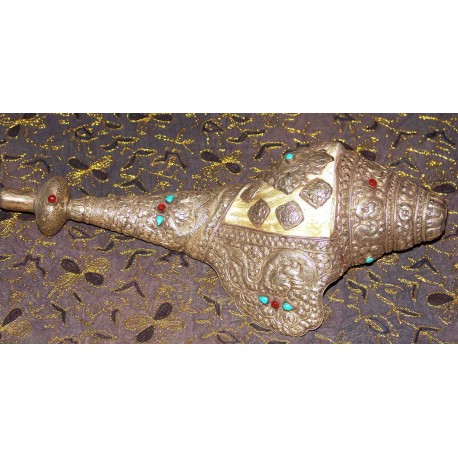No products
- English
- Ελληνικά
 View larger
View larger
- Remove this product from my favorite's list.
- Add this product to my list of favorites.
Ceremonial /decorative Conch Shell Trumpet from Nepal
New product
1 Item
Warning: Last items in stock!
Silver Ceremonial Conch Shell Trumpet 42cm length 18cm wide weight 1.7 kg
VERY RARE COUNTERCLOCKWISE CONCH.
..a real masterpiece of Handmade work on SILVER , with the 8 Auspicious symbols of Buddhism as main design ,togather with coral and turquoise stones.....
The conch shell (Sanskrit shankha; Tibetan dung dkar) has survived as the original horn trumpet since time immemorial. Ancient Indian epics describe how each hero of mythical warfare carried a mighty white conch shell, which often bore a personal name.
Today, in its greatly tamed avatar, the conch is used in Tibetan Buddhism to call together religious assemblies. During the actual practise of rituals, it is used both as a musical instrument and as a container for holy water.Based on its direction of coiling, the shankha has two varieties:[3][4]
[edit]
- A Dakshinavarti Shankh: This is the very rare sinistral form of the species, where the shell coils or whorls expand in a counterclockwise spiral if viewed from the apex of the shellThe Dakshinavarta shankha is believed to be the abode of the wealth goddess Lakshmi - the consort of Vishnu, and hence this type of shankha is considered ideal for medicinal use. It is a very rare variety from the Indian Ocean. This type of shankha has three to seven ridges visible on the edge of the aperture and on thecolumella and has a special internal structure. The right spiral of this type reflects the motion of the planets. It is also compared with the hair whorls on the Buddha's head that spiral to the right. The long white curl between Buddha's eyebrows and the conch-like swirl of his navel are also akin to this shankha
- The Vamavarta ("left-turned" as viewed with the aperture uppermost): This is the very commonly occurring dextral form of the species, where the shell coils or whorls expand in a clockwise spiral when viewed from the apex of the shell. In Hinduism, a dakshinavarta shankha symbolizes infinite space and is associated with Vishnu. The Vamavarta shankha represents the reversal of the laws of nature and is linked with Shiva.
The * Auspicious Symbols " :
The Umbrella or parasol (chhatra): It embodies notions of wealth or royalty, for one had to be rich enough to possess such an item, and further, to have someone carry it. It points to the "royal ease" and power experienced in the Buddhist life of detachment. It also symbolizes the wholesome activities to keep beings from illness, harmful forces, obstacles and so forth, and the enjoyment of the results under its cool shade.
The Golden Fish (matsya): These represent good fortune in general, for Hindus, Jain and Buddhists. Within Buddhism it also symbolizes that living beings who practice the dharma need have no fear to drown in the ocean of suffering, and can freely migrate (chose their rebirth) like fish in the water.
The Treasure Vase (bumpa): It is a sign of the inexhaustible riches available in the Buddhist teachings, but also symbolizes long life, wealth, prosperity and all the benefits of this world.
The Lotus (padma): The lotus refers to many aspects of the path, as it grows from the mud (samsara), up through muddy water it appears clean on the surface (purification), and finally produces a beautiful flower (enlightenment). The white blossom represents purity, the stem stands for the practice of Buddhist teachings which raise the mind above the (mud of) worldly existence, and gives rise to purity of mind. An open blossom signifies full enlightenment; a closed blossom signifies the potential for enlightenment.
The Conch (shankha): It is symbolizes the deep, far reaching and melodious sound of the teachings, which is suitable for all disciples at it awakens them from the slumber of ignorance to accomplish all beings' welfare.
The Auspicious or Endless Knot (shrivatsa): It is a geometric diagram which symbolizes the nature of reality where everything is interrelated and only exists as part of a web of karma and its effect. Having no beginning or end, it also represents the infinite wisdom of the Buddha, and the union of compassion and wisdom. Also, it represents the illusory character of time, and long life as it is endless.
The Victory Banner (dhvaja): It symbolizes the victory of the Buddha's teachings over death, ignorance, disharmony and all the negativities of this world, and victory over. The roofs of Buddhist monasteries are often decorated with victory banners of different shapes and sizes.
The Dharma-Wheel (Dharmachakra): It is said that after Siddharta Gautama achieved enlightenment, Brahma came to him, offered a Dharma-Wheel and requested the Buddha to teach. It represents the Buddhist teachings.








